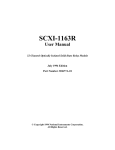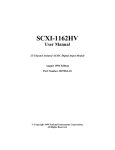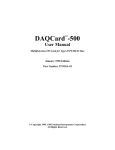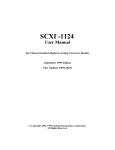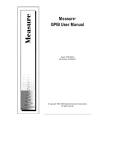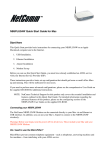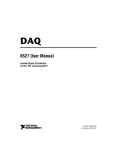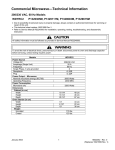Download ER-8/16 User Manual - National Instruments
Transcript
ER-8/16 User Manual An 8-Channel or 16-Channel SPDT Relay Accessory for Data Acquisition Boards December 1996 Edition Part Number 371197A-01 © Copyright 1995, 1996 National Instruments Corporation. All Rights Reserved. National Instruments Corporate Headquarters 6504 Bridge Point Parkway Austin, TX 78730-5039 (512) 794-0100 Technical support fax: (800) 328-2203 (512) 794-5678 Branch Offices: Australia 03 9879 5166, Austria 0662 45 79 90 0, Belgium 02 757 00 20, Canada (Ontario) 905 785 0085, Canada (Québec) 514 694 8521, Denmark 45 76 26 00, Finland 09 527 2321, France 01 48 14 24 24, Germany 089 741 31 30, Hong Kong 2645 3186, Israel 03 5734815, Italy 02 413091, Japan 03 5472 2970, Korea 02 596 7456, Mexico 5 520 2635, Netherlands 0348 433466, Norway 32 84 84 00, Singapore 2265886, Spain 91 640 0085, Sweden 08 730 49 70, Switzerland 056 200 51 51, Taiwan 02 377 1200, U.K. 01635 523545 Limited Warranty The ER-8 or ER-16 is warranted against defects in materials and workmanship for a period of one year from the date of shipment, as evidenced by receipts or other documentation. National Instruments will, at its option, repair or replace equipment that proves to be defective during the warranty period. This warranty includes parts and labor. The media on which you receive National Instruments software are warranted not to fail to execute programming instructions, due to defects in materials and workmanship, for a period of 90 days from date of shipment, as evidenced by receipts or other documentation. National Instruments will, at its option, repair or replace software media that do not execute programming instructions if National Instruments receives notice of such defects during the warranty period. National Instruments does not warrant that the operation of the software shall be uninterrupted or error free. A Return Material Authorization (RMA) number must be obtained from the factory and clearly marked on the outside of the package before any equipment will be accepted for warranty work. National Instruments will pay the shipping costs of returning to the owner parts which are covered by warranty. National Instruments believes that the information in this manual is accurate. The document has been carefully reviewed for technical accuracy. In the event that technical or typographical errors exist, National Instruments reserves the right to make changes to subsequent editions of this document without prior notice to holders of this edition. The reader should consult National Instruments if errors are suspected. In no event shall National Instruments be liable for any damages arising out of or related to this document or the information contained in it. EXCEPT AS SPECIFIED HEREIN, N ATIONAL INSTRUMENTS MAKES NO WARRANTIES, EXPRESS OR IMPLIED, AND SPECIFICALLY DISCLAIMS ANY WARRANTY OF MERCHANTABILITY OR FITNESS FOR A PARTICULAR PURPOSE . CUSTOMER’S RIGHT TO RECOVER DAMAGES CAUSED BY FAULT OR NEGLIGENCE ON THE PART OF NATIONAL INSTRUMENTS SHALL BE LIMITED TO THE AMOUNT THERETOFORE PAID BY THE CUSTOMER. NATIONAL INSTRUMENTS WILL NOT BE LIABLE FOR DAMAGES RESULTING FROM LOSS OF DATA, PROFITS, USE OF PRODUCTS, OR INCIDENTAL OR CONSEQUENTIAL DAMAGES, EVEN IF ADVISED OF THE POSSIBILITY THEREOF. This limitation of the liability of National Instruments will apply regardless of the form of action, whether in contract or tort, including negligence. Any action against National Instruments must be brought within one year after the cause of action accrues. National Instruments shall not be liable for any delay in performance due to causes beyond its reasonable control. The warranty provided herein does not cover damages, defects, malfunctions, or service failures caused by owner’s failure to follow the National Instruments installation, operation, or maintenance instructions; owner’s modification of the product; owner’s abuse, misuse, or negligent acts; and power failure or surges, fire, flood, accident, actions of third parties, or other events outside reasonable control. Copyright Under the copyright laws, this publication may not be reproduced or transmitted in any form, electronic or mechanical, including photocopying, recording, storing in an information retrieval system, or translating, in whole or in part, without the prior written consent of National Instruments Corporation. Trademarks LabVIEW ®, NI-DAQ ®, DAQCardTM, DAQPadTM, and SCXITM are trademarks of National Instruments Corporation. Product and company names listed are trademarks or trade names of their respective companies. WARNING REGARDING MEDICAL AND CLINICAL USE OF NATIONAL INSTRUMENTS PRODUCTS National Instruments products are not designed with components and testing intended to ensure a level of reliability suitable for use in treatment and diagnosis of humans. Applications of National Instruments products involving medical or clinical treatment can create a potential for accidental injury caused by product failure, or by errors on the part of the user or application designer. Any use or application of National Instruments products for or involving medical or clinical treatment must be performed by properly trained and qualified medical personnel, and all traditional medical safeguards, equipment, and procedures that are appropriate in the particular situation to prevent serious injury or death should always continue to be used when National Instruments products are being used. National Instruments products are NOT intended to be a substitute for any form of established process, procedure, or equipment used to monitor or safeguard human health and safety in medical or clinical treatment. Contents About This Manual ............................................................................................................ix Organization of This Manual .........................................................................................ix Conventions Used in This Manual.................................................................................x National Instruments Documentation ............................................................................xi Customer Communication .............................................................................................xii Chapter 1 Introduction ..........................................................................................................................1-1 About the ER-8/16 .........................................................................................................1-1 What You Need to Get Started ......................................................................................1-1 Optional Equipment .......................................................................................................1-2 Software .........................................................................................................................1-2 Unpacking ......................................................................................................................1-2 Chapter 2 Setup ........................................................................................................................................2-1 Safety Information .........................................................................................................2-4 Connecting the ER-8/16 to Your DAQ Device .............................................................2-5 Chapter 3 Signal Connections .............................................................................................................3-1 Front Connectors............................................................................................................3-1 Using DIO-24 Devices.......................................................................................3-1 Using DIO-32 Boards ........................................................................................3-2 Power Supply .................................................................................................................3-2 Channel Connections .....................................................................................................3-3 Power-up Conditions..........................................................................................3-4 Wire Gauge ........................................................................................................3-4 Channel Isolation ...............................................................................................3-4 Contact Protection for Inductive Loads .............................................................3-4 Connecting Your Signal Lines.......................................................................................3-6 Internal Connectors........................................................................................................3-7 Daisy Chaining the ER-8/16 ..............................................................................3-8 Using the SC-205X Series with the ER-8......................................................................3-8 DAQ System Configurations with the ER-8/16.............................................................3-9 Chapter 4 Theory of Operation ..........................................................................................................4-1 Functional Overview......................................................................................................4-1 Digital Interface .............................................................................................................4-3 Relay Channels ..............................................................................................................4-3 © National Instruments Corporation v ER-8/16 User Manual Contents Appendix A Specifications ........................................................................................................................A-1 Appendix B I/O Connectors .....................................................................................................................B-1 Appendix C Contact Protection ..............................................................................................................C-1 Appendix D Takamisawa VE Series Relay Technical Data .........................................................D-1 Appendix E Customer Communication...............................................................................................E-1 Glossary ...................................................................................................................... Glossary-1 Index ..................................................................................................................................Index-1 ER-8/16 User Manual vi © National Instruments Corporation Contents Figures Figure 2-1. Figure 2-2. ER-8/16 Parts Locator Diagram.........................................................................2-2 The ER-8/16 Front Connector............................................................................2-7 Figure Figure Figure Figure Contact Protection Using a Flyback Diode for DC Loads.................................3-5 Arc Suppressor Pad Locations for Channel 1 ....................................................3-6 ER-8/16 Configurations with DIO Devices.......................................................3-9 ER-8/16 Configurations with Multifunction DAQ Devices ..............................3-10 3-1. 3-2. 3-3. 3-4. Figure 4-1. Figure 4-2. ER-8/16 Block Diagram.....................................................................................4-2 ER-8/16 Onboard Equivalent Circuit.................................................................4-3 Figure B-1. Figure B-2. Figure B-3. The DIO-24 Connector ......................................................................................B-1 The DIO-32 Connector ......................................................................................B-3 26-Pin Internal Connectors ................................................................................B-5 Tables Table 2-1. Parts Locator Diagram Descriptions..................................................................2-3 Table 3-1. Table 3-2. Arc Suppressor Placement, COM to NO ...........................................................3-5 Arc Suppressor Placement, COM to NC ...........................................................3-6 Table Table Table Table DIO-24 Connector Pin Descriptions..................................................................B-2 DIO-32 Connector Pin Descriptions..................................................................B-4 26-Pin IN Connector Pin Descriptions...............................................................B-5 26-Pin OUT Connector Pin Descriptions...........................................................B-6 B-1. B-2. B-3. B-4. © National Instruments Corporation vii ER-8/16 User Manual About This Manual This manual describes the electrical and mechanical aspects of the ER-8 and ER-16 and contains information concerning their setup, operation, and safety. Both the ER-8 and ER-16 are singlepole double-throw (SPDT) relay accessories for use with other data acquisition (DAQ) products. The ER-8 has eight channels; the ER-16 has 16 channels. Throughout this manual, ER-8/16 refers to either the ER-8 or ER-16, unless otherwise noted. The ER-8/16 interfaces to any National Instruments DAQ device with digital I/O capabilities for the Macintosh and PC/XT/AT (AT Series, Lab) computers. More specifically, the National Instruments product families that interface with the ER-8/16 are the DIO-24, DIO-32, Lab, E Series, MIO, DAQCards, and 1200 Series devices. This accessory is designed for low-cost control applications in laboratory testing, production testing, and industrial process monitoring and control. Organization of This Manual The ER-8/16 User Manual is organized as follows: • Chapter 1, Introduction, describes the ER-8/16; lists what you need to get started and optional equipment; describes software support; and explains how to unpack the ER-8/16. • Chapter 2, Setup, describes how to set up the ER-8/16. • Chapter 3, Signal Connections, describes the signal connections, channel connections, and digital interface to the ER-8/16. • Chapter 4, Theory of Operation, contains a functional overview of the ER-8/16 and explains the operation of each functional unit making up the ER-8/16. • Appendix A, Specifications, lists the specifications of the ER-8/16. • Appendix B, I/O Connectors, contains the connector pinouts and pin descriptions for the ER-8/16. • Appendix C, Contact Protection, contains technical data on contact protection when you are switching inductive loads. • Appendix D, Takamisawa VE Series Relay Technical Data, contains a manufacturer data sheet for the relay used on the ER-8/16. • Appendix E, Customer Communication, contains forms you can use to request help from National Instruments or to comment on our products. • The Glossary contains an alphabetical list and description of terms used in this manual, including abbreviations, acronyms, metric prefixes, mnemonics, symbols, and terms. © National Instruments Corporation ix ER-8/16 User Manual About This Manual • The Index contains an alphabetical list of key terms and topics used in this manual, including the page where each one can be found. Conventions Used in This Manual The following conventions are used in this manual: bold Bold text denotes menu items, function panel items, and dialog box buttons or options. italic Italic text denotes emphasis, a cross reference, or an introduction to a key concept. bold italic Bold italic text denotes a note, caution, or warning. <> Angle brackets containing numbers separated by an ellipsis represent a range of values associated with a bit, signal name, or port (for example, ACH<0..7> stands for ACH0 through ACH7). device Device refers generically to National Instruments boards, cards, or modules. ER-8/16 ER-8/16 refers to the ER-8 or ER-16 unless otherwise noted. DIO device DIO device refers to National Instruments digital I/O devices such as the AT-DIO-32F, NB-DIO-24, NB-DIO-96, NB-DIO-32F, PC-DIO-24, DAQCard-DIO-24, and PC-DIO-96, unless otherwise noted. DIO-24 device DIO-24 device refers to the National Instruments NB-DIO-24, DAQCard-DIO-24, and PC-DIO-24 digital I/O devices unless otherwise noted. DIO-32 board DIO-32 board refers to the National Instruments AT-DIO-32F and NB-DIO-32F digital I/O boards unless otherwise noted. DIO-type board DIO-type board refers to the National Instruments DIO boards with only digital I/O capabilities. These boards include the DIO-24, DIO-32F, and DIO-96 boards unless otherwise noted. Lab board Lab board refers to the National Instruments Lab-LC, Lab-NB, Lab-PC, and Lab-PC+ boards unless otherwise noted. E Series device E Series device refers to National Instruments digital I/O devices such as the AT-MIO-16E-2, AT-MIO-64E-3, AT-MIO-16E-10, AT-MIO-16DE-10, AT-MIO-16XE-50, NEC-MIO-16E-4, and NEC-AI-16XE-50, unless otherwise noted. MIO board MIO board refers to National Instruments boards such as the AT-MIO-16F-5, AT-MIO-16D, AT-MIO-64F-5, AT-MIO-16, and AT-MIO-16X unless otherwise noted. ER-8/16 User Manual x © National Instruments Corporation About this Manual DAQCard DAQCard refers to National Instruments cards such as the DAQCard-500 and DAQCard-700 unless otherwise noted. 1200 Series 1200 Series refers to the National Instruments DAQPad-1200 and DAQCard-1200 unless otherwise noted. NB NB refers to the NuBus Series computers. NI-DAQ NI-DAQ is used in this manual to refer to the NI-DAQ software for Macintosh and PC compatibles unless otherwise noted. Macintosh Macintosh refers to all Macintosh II, Macintosh Quadra, and Macintosh Centris computers except the Centris 610 unless otherwise noted. PC PC refers to PC/XT/AT and IBM PS/2, models 25 and 30, computers. Port A Port A is used in this manual to refer to port A or port 0 (as in your NI-DAQ manuals). Port B Port B is used in this manual to refer to port B or port 1 (as in your NI-DAQ manuals). Port C Port C is used in this manual to refer to port C or port 2 (as in your NI-DAQ manuals). Port D Port D is used in this manual to refer to port D or port 3 (as in your NI-DAQ manuals). Abbreviations, acronyms, metric prefixes, mnemonics, symbols, and terms are listed in the Glossary. National Instruments Documentation The ER-8/16 User Manual is one piece of the documentation set for your DAQ system. You could have any of several types of manuals, depending on the hardware and software in your system. Use the different types of manuals you have as follows: • Your DAQ hardware user manuals—These manuals have detailed information about the DAQ hardware that plugs into or is connected to your computer. Use these manuals for hardware installation and configuration instructions, specification information about your DAQ hardware, and application hints. • Software manuals—Examples of software manuals you may have are the LabVIEW and LabWindows/CVI manual sets and the NI-DAQ manuals. After you set up your hardware system, use either the application software (LabVIEW or LabWindows/CVI) manuals or the NI-DAQ manuals to help you write your application. If you have a large and complicated system, it is worthwhile to look through the software manuals before you configure your hardware. © National Instruments Corporation xi ER-8/16 User Manual About This Manual • Accessory installation guides or manuals—If you are using accessory products, read the terminal block and cable assembly installation guides or accessory device user manuals. They explain how to physically connect the relevant pieces of the system. Consult these guides when you are making your connections. Customer Communication National Instruments wants to receive your comments on our products and manuals. We are interested in the applications you develop with our products, and we want to help if you have problems with them. To make it easy for you to contact us, this manual contains comment and configuration forms for you to complete. These forms are in Appendix E, Customer Communication, at the end of this manual. ER-8/16 User Manual xii © National Instruments Corporation Chapter 1 Introduction This chapter describes the ER-8/16; lists what you need to get started and optional equipment; describes software support; and explains how to unpack the ER-8/16. About the ER-8/16 Thank you for buying the National Instruments ER-8/16. The ER-8 consists of eight isolated single-pole double-throw (SPDT) or form C relay channels. The ER-16 consists of 16 isolated SPDT or form C relay channels. The ER-8/16 can serve as a controller or switcher in laboratory testing, production testing, and industrial-process monitoring and control applications. The ER-8/16 operates with full functionality with most National Instruments digital I/O products. It also interfaces with the Lab and MIO boards using the SC-205X Series cable adapters. The ER-8/16 has onboard screw terminals for easy wire attachment. You can also build a 32-channel ER system by daisy-chaining two ER-16s. Detailed ER-8/16 specifications are in Appendix A, Specifications. What You Need to Get Started To set up and use your ER-8/16, you will need the following: ER-8 or ER-16 ER-8/16 User Manual Your DIO-24, DIO-32, Lab, E Series, MIO, DAQCard, or 1200 Series device and documentation SC-205X Series cable adapter if you are using a Lab or MIO board Interface cable (different for DIO-24 and DIO-32 devices, DAQCards, and SC-205X Series adapters) Your computer © National Instruments Corporation 1-1 ER-8/16 User Manual Introduction Chapter 1 Optional Equipment You can use the following National Instruments products with your ER-8/16. • • • • • • • • • • • • • Any National Instruments DAQ device with digital I/O capability SC-2050 cable adapter with NB1 cable SC-2051 cable adapter with NB1 cable SC-2052 cable adapter with NB1 cable SC-2053 cable adapter with NB1 cable SC-2054 48-channel kit with NB5 cable SC-2054 96-channel kit with NB5 cable SC-2055 cable adapter with NB1 cable NB7 cable assembly SH6850 shielded cable R6850 ribbon cable R1005050 ribbon cable Type NB5 cable For more information about optional equipment available from National Instruments, refer to your National Instruments catalog or call the office nearest you. Refer to Chapter 3, Signal Connections, for additional information on cabling, connectors, and adapters. Software The ER-8/16 requires no additional software beyond what you are using for your DAQ device. Unpacking Your ER-8/16 is shipped in an antistatic package to prevent electrostatic damage to the unit. Electrostatic discharge can damage several components on the ER-8/16. To avoid such damage in handling the unit, take the following precautions: • Ground yourself via a grounding strap or by holding a grounded object. • Touch the antistatic package to a metal part of your computer chassis before removing the ER-8/16 from the package. • Remove the unit from the package and inspect it for loose components or any other sign of damage. Notify National Instruments if the ER-8/16 appears damaged in any way. Do not install a damaged unit. • Never touch the exposed pins of connectors. ER-8/16 User Manual 1-2 © National Instruments Corporation Chapter 2 Setup This chapter describes how to set up the ER-8/16. The ER-8 has eight SPDT relays controlled by eight digital lines. Each of these relays has a normally closed (NC) contact that connects to the common (COM) contact when the corresponding digital output line is low, and a normally open (NO) contact that connects to the COM contact when the digital line is high. The contacts are break-before-make so that all three contacts are never shorted. The ER-8/16 is an accessory to National Instruments DAQ devices with digital I/O. No hardware or software configuration is necessary. To configure the DAQ device driving the ER-8/16, refer to your DAQ hardware user manual. Figure 2-1 shows the parts locator diagram for the ER-8/16. See Table 2-1 for detailed descriptions of the parts called out on the parts locator diagram. © National Instruments Corporation 2-1 ER-8/16 User Manual Setup Chapter 2 5 6 4 3 2 7 1 11 1 2 3 Power LED SW1—power supply switch Channel 1 LED 4 5 6 9 10 Channel 1 Relay Screw Terminals Surge Protector Pads 7 8 9 8 J8—EXT power supply conn. 10 J3—26-pin OUT conn. 11 Fuses J2—26-pin IN conn. J1—DIO-24 and DIO-32 conn. Figure 2-1. ER-8/16 Parts Locator Diagram ER-8/16 User Manual 2-2 © National Instruments Corporation Chapter 2 Setup Table 2-1. Parts Locator Diagram Descriptions Callout Name Description 1 Power LED When illuminated red, this LED indicates that the ER-8/16 is receiving power. 2 SW1 This is the main +5 V power supply switch for selecting external or internal supply. Move the switch to EXT if using external supply and to INT if using internal (driving device or ER-16) supply. By default, your ER-8/16 is shipped with SW1 in the EXT position. 3 Channel 1 LED These DS<1..16> LEDs are illuminated green when the NO contact is shorted to the COM contact for the respective channel. Otherwise the LED is shut off. 4 Channel 1 Relay These K<1..16> relays are controlled digitally on the ER-8/16. 5 Screw Terminals The NC<1..16> screw terminals are for the NC contact for channels 1 through 16. The NO<1..16> screw terminals are for the NO contact for channels 1 through 16. The COM<1..16> screw terminals are for the COM contact for the channels 1 through 16. 6 Surge Protector Pads The M<1..16> pads across NC and COM contacts are for protecting the relay contacts from inductive loads. A resistor and capacitor combination can be placed across these pads to suppress sparking on the relay contacts due to inductive loads. The N<1..16> pads across NO and COM contacts are for protecting the relay contacts from inductive loads. A resistor and capacitor combination can be placed across these pads to suppress sparking on the relay contacts due to inductive loads. 7 J8 This external power-supply connector, EXT +5 V, is for external +5 V supply. EXT GND is the reference for the external +5 V supply, and is connected to the ER-8/16 ground. 8 J3 This 26-pin OUT connector sends the 26-pin daisy-chain cable to the ER-8 or the ER-16. 9 Fuses F1 and F2 are socketed power supply fuses. You may replace these fuses if they are blown. The fuse is LIT-PICOII, 2 A, 125 V, fast. 10 J2 This 26-pin IN connector receives the 26-pin daisy-chain cable from the ER-16 or SC-205X cable adapter. 11 J1 This 50-pin dual connector has the top connector for DIO-32 boards, and the bottom connector for DIO-24 devices. © National Instruments Corporation 2-3 ER-8/16 User Manual Setup Chapter 2 Safety Information The following warnings contain important safety information concerning hazardous voltages. ! Warning: Connections that exceed any of the maximum input signal ratings on the ER-8/16 can create a shock or a fire hazard, or damage the ER-8/16, your computer, and the DAQ device. Maximum input ratings for each signal are given in Appendix A, Specifications. National Instruments is NOT liable for any damages resulting from signal connections that exceed any of these ratings. Do not operate your ER-8/16 in an explosive atmosphere or where there may be flammable gases or fumes. KEEP AWAY FROM LIVE CIRCUITS. DO NOT REMOVE THE TOP COVER of the ER-8/16 when it is operating or is powered on. If signal wires are connected to the unit, dangerous voltages may exist even when the equipment is turned off. To avoid dangerous electrical shock, do not perform procedures involving cover removal unless you are qualified to do so. Before removing the cover make sure that the computer and the power supply are turned off and that the signal wires connected to the screw terminals do not contain live voltages. DO NOT OPERATE DAMAGED EQUIPMENT. The safety protection features built into your ER-8/16 can become impaired if it is damaged in any way. If necessary, return the unit to National Instruments for service and repair to ensure that safety is not compromised. DO NOT SUBSTITUTE PARTS OR MODIFY EQUIPMENT. To avoid introducing additional hazards, do not install unauthorized parts or modify your ER-8/16. If necessary, return the unit to National Instruments for service and repair to ensure that safety is not compromised. When using the unit with high common mode voltages, you must insulate your signal wires appropriately. National Instruments is NOT liable for any damages or injuries resulting from inadequate signal wire insulation. When connecting or disconnecting signal lines to the ER-8/16 screw terminal, verify that the lines are powered off. Potential differences between the lines and the ER-8/16 ground create a shock hazard while you connect the lines. Connections, including power signals to ground and vice versa, that exceed any of the maximum signal ratings on the ER-8/16 can create a shock or a fire hazard, or can damage any or all of the devices connected to the ER-8/16, the host computer, and the ER-8/16. National Instruments is NOT liable for any damages or injuries resulting from incorrect signal connections. ER-8/16 User Manual 2-4 © National Instruments Corporation Chapter 2 Setup Use and connect to only one of the following connectors when operating the ER-8/16: the DIO-24, DIO-32, or IN connector. National Instruments is NOT liable for any damages resulting from incorrect connections. Equipment described in this document must be used in an Installation Category II environment per IEC 664. This category requires local level supply mains-connected installation. Do not operate this equipment in a manner that contradicts the information specified in this document. Misuse of this equipment could result in a shock hazard. Terminals are for use only with equipment that has no accessible live parts. Use only 26-16 AWG wire with a voltage rating of 300 V and 60° C for controlling 250 V. Prepare your signal wire by stripping the insulation no more than 7 mm. Connect the signal wires to the screw terminals by inserting the stripped end of the wire fully into the terminals. Tighten the terminals to a torque of 57 in.-lb. Clean devices and terminal blocks by brushing off light dust with a soft, nonmetallic brush. Remove other contaminants with deionized water and a stiff nonmetallic brush. The unit must be completely dry and free from contaminants before returning to service. Connecting the ER-8/16 to Your DAQ Device The following are general instructions for setting up your ER-8/16. Consult your computer user manual or technical reference manual for specific instructions and warnings. Warning: 1. Connections that exceed any of the maximum rating of the input signals on the ER-8/16 can damage the ER-8/16, your computer, and the DAQ device. Maximum input ratings for each signal are given in Appendix A, Specifications. National Instruments is NOT liable for any damages resulting from signal connections that exceed any of these ratings. Turn off the host computer power before making any connections. Warning: Keep away from live circuits. DO NOT REMOVE THE TOP COVER of the ER-8/16 when it is operating or is powered on. If signal wires are connected to the unit, dangerous voltages may exist even when the equipment is turned off. To avoid dangerous electrical shock, do not perform procedures involving cover removal unless you are qualified to do so. Before removing the cover make sure that the computer and the power supply are turned off and that the signal wires connected to the screw terminals do not contain live voltages. © National Instruments Corporation 2-5 ER-8/16 User Manual Setup Chapter 2 2. Remove the top cover of your ER-8/16 by removing the four screws located on the bottom of your unit. 3. Connect the 50-pin interfacing cable to the appropriate 50-pin connector located on the front end of the ER-8/16 as shown in Figure 2-2. • If you are connecting a DIO-24 device to the ER-8/16, use the DIO-24 50-pin connector. This is the bottom connector. • If you are connecting a DIO-32 board to the ER-8/16, use the DIO-32 50-pin connector. This is the top connector. Warning: Connecting the cable to the wrong connector can damage the ER-8/16 or your DAQ device. National Instruments is NOT liable for any damages resulting from such connections. Only one of the following connectors should be used and connected when operating the ER-8/16: the DIO-24, DIO-32, or IN connector. National Instruments is NOT liable for any damages resulting from any other connections. • 4. If you are daisy chaining the ER-8/16 or using the SC-205X Series cable adapter, connect the 26-pin cable to the correct 26-pin connector, either IN or OUT. For additional information on signal connections and cabling refer to Chapter 3, Signal Connections. Switch the +5 V power supply switch (SW1) to the correct position, either INT or EXT. The switch position depends on the number of channels and the type of DAQ device you are using with the ER-8/16. Set the switch to INT if you are using your DAQ device’s internal +5 V supply. Set the switch to EXT if you are using an external +5 supply. For additional information on power supply connections, refer to the Power Supply section in Chapter 3, Signal Connections. Note: By default, your ER-8/16 is shipped with SW1 set to the EXT position. 5. Verify the connections and setup. 6. Turn on the external power supply, if necessary, then turn on your computer. The red Power LED should light up indicating that the ER-8/16 is receiving power. If the red Power LED does not light up, verify that the power supply connections and electrical power supply are switched ON. If the connections and external power supply are working, check the electrical continuity on fuses F1 and F2. If the continuity test fails on these fuses, a fuse is blown. You can either replace the fuse yourself or send it to National Instruments for replacement. Note: The fuses are socketed. If you choose to replace them yourself, the fuse specification is LIT-PICOII, 2 A, 125 V, fast. The manufacturer is Littelfuse, and the manufacturer part number is R251002T1. ER-8/16 User Manual 2-6 © National Instruments Corporation Chapter 2 7. Setup You can now test your ER-8/16 without making any connections to the screw terminals by writing to port A (0). When you write a digital 1 to port A (0), the DS1 LED should turn green, indicating it is ON. You may also hear a clicking sound. Port A (0) corresponds to channel 1 on the ER-8/16. Use this procedure to test all the channels on your ER-8/16. Note: LEDs are present only for verifying your digital cable connections. Warning: connect any wires to the channel screw terminals when you are conducting this test. National Instruments is NOT liable for any damages resulting from such connections. DO NOT If the ER-8/16 does not respond to the control signals, check your cable connections and try again. If the test fails again, contact National Instruments. 8. Switch off your computer and the external power supply. Make wire connections to the ER-8/16 channels by wiring to the proper screw terminals, marked NC, COM, and NO. For additional information, refer to the Channel Connections section in Chapter 3, Signal Connections. 9. When you have connected the wires, check the connections again. 10. Replace the top cover and screw it on tightly. 11. Turn on your computer and the external power supply. Your ER-8/16 is now ready for operation. TOP BOTTO: DIO-32 M: DIO-2 4 Figure 2-2. The ER-8/16 Front Connector © National Instruments Corporation 2-7 ER-8/16 User Manual Chapter 3 Signal Connections This chapter describes the signal connections, channel connections, and digital interface to the ER-8/16. Front Connectors This section describes the signal connections to the ER-8/16 via the I/O connectors for the digital interface. Warning: Connections that exceed any of the maximum ratings of the input signals on the ER-8/16 can damage the ER-8/16, your computer, and the DAQ device. Maximum input ratings for each signal are given in Appendix A, Specifications. National Instruments is NOT liable for any damages resulting from signal connections that exceed any of these ratings. Turn off signal sources before connecting or disconnecting any additional signal. attempt to connect your ER-8/16 to any connector for which it is not designed. Incorrect connection can damage your ER-8/16 or the host computer. National Instruments is NOT liable for any damages resulting from incorrect connections. DO NOT The front end of the ER-8/16 has two 50-pin connectors. The top connector, DIO-32, is for interfacing to DIO-32 boards, and the bottom connector, DIO-24, is for interfacing to DIO-24 devices. Warning: Use only one connector, either the DIO-24 or the DIO-32 connector. DO NOT connect cables to both connectors. Connecting the cable to the wrong connector can damage the ER-8/16 or your DAQ device. National Instruments is NOT liable for any damages resulting from such connections. Using DIO-24 Devices If you are using a National Instruments DIO-24 device to control the ER-8/16, connect the cable to the DIO-24 connector. © National Instruments Corporation 3-1 ER-8/16 User Manual Signal Connections Chapter 3 You can control a maximum of 24 channels using this connector, one ER-16, and one ER-8. Daisy chain the ER-8 to the ER-16 using the NB7 cable. The ER-8 uses port A<0..7> to control channels 1 through 8. Port C<0..7> wraps back to the 26-pin OUT connector. The ER-16 uses port A<0..7> to control channels 1 through 8 and port B<0..7> to control channels 9 through 16. Port C<0..7> wraps back to the 26-pin OUT connector. For additional information on daisy chaining, refer to the Daisy Chaining the ER-8/16 section later in this chapter. Using DIO-32 Boards If you are using a National Instruments DIO-32 board to control the ER-8/16, connect the cable to the DIO-32 connector. Note: You will need an external +5 V power supply if you use this connector. Warning: Connecting the cable to the wrong connector can damage the ER-8/16 or your DAQ device. National Instruments is NOT liable for any damages resulting from such connections. You can control a maximum of 32 channels using the DIO-32 connector and two ER-16s. Daisy chain one ER-16 to the other ER-16 using the NB7 cable. The ER-16 uses port A<0..7> to control channels 1 through 8 and port B<0..7> to control channels 9 through 16. Port C<0..7> and port D<0..7> wrap back to the 26-pin OUT connector. For additional information on daisy chaining refer to the Daisy Chaining the ER-8/16 section later in this chapter. Power Supply You can use either your DAQ device’s internal +5 V supply or an external +5 V supply to power up your ER-8/16. If you use an external +5 V supply, use the two screw terminals to connect external +5 V and GND. Refer to Figure 2-1 in Chapter 2, Setup, for the location of this screw terminal on the ER-8/16. Warning: Connections that exceed any of the input signal maximum ratings on the ER-8/16 can damage the ER-8/16, your computer, and the DAQ device. Maximum input ratings for each signal are given in Appendix A, Specifications. National Instruments is NOT liable for any damages resulting from signal connections that exceed any of these ratings. ER-8/16 User Manual 3-2 © National Instruments Corporation Chapter 3 Signal Connections Current requirements for the ER-8/16 are as follows: Channels 8 16 24 32 Current (Amps) 0.5 A 1.0 A 1.5 A 2.0 A If you use its internal +5 V supply setting, make sure your device can supply the required amount of +5 V power to the ER-8/16. Note: DIO-32F boards do not provide internal +5 V supply. You will need an external +5 V supply for DIO-32F boards. DAQCard-DIO-24 and other DAQCards can provide a maximum of 500 mA of current. You can drive only one ER-8 with the internal supply. You will need an external +5 V supply for driving more than eight channels. In addition to the above note, refer to Figures 3-3 and 3-4 for information on configurations that require an external +5 V supply. When you connect more than one ER-8 with any of the SC-205X Series cable adapters, you will need an external +5 V power supply. Warning: Connecting the cable to the wrong connector can damage the ER-8/16 or your DAQ device. National Instruments is NOT liable for any damages resulting from such connections. Use and connect only one of the following connectors when operating the ER-8/16: the DIO-24, DIO-32, or IN connector. National Instruments is NOT liable for any damages resulting from incorrect connections. If you use your DAQ device’s internal +5 V supply, make sure that the power supply switch (SW1) is set to the INT position. If you are using an external +5 V supply, make sure that SW1 is set to the EXT position. Refer to Figure 2-1 for the location of the SW1 switch. Note: By default, your ER-8/16 is shipped with SW1 set to the EXT position. Channel Connections The ER-8/16 has 26 screw terminals. Twenty-four of these screw terminals are for connecting the loads to the relay channels and two screw terminals are for providing the external +5 V supply to the unit. Each channel consists of a COM position, an NC position, and an NO position. © National Instruments Corporation 3-3 ER-8/16 User Manual Signal Connections Chapter 3 Power-up Conditions When the digital interface cable is not connected to either connector, the COM contact is connected to the relay NC contact at power up. When the digital interface cable is connected to any of the connectors, the power-up state depends on the power-up state of the digital signals on the DAQ device. If the power-up state of the digital lines driving the ER-8/16 is low, the COM contact is connected to the relay NC contact. If the power-up state of the digital lines driving the ER-8/16 is high, the COM contact is connected to the relay NO contact. Wire Gauge When using the ER-8, you can use up to 16 AWG gauge wire for all channels. If you are using the ER-16 and all channels are in use, use 18 AWG gauge wire, maximum. Warning: When using the ER-8/16 with high voltages, you must insulate your signal wires appropriately. National Instruments is NOT liable for any damages or injuries resulting from inadequate signal wire insulation. Make sure that your wires are properly insulated to avoid any short circuit to the other channels, ground, or any other point on the printed wire board (PWB). Channel Isolation All contacts have a working voltage of 250 VAC or 30 VDC. This product complies with IEC-1010 for Voltage Installation Category II Pollution Degree 2. Refer to the specifications listed in Appendix A, Specifications, for further details before connecting the signals to the relay contacts. Contact Protection for Inductive Loads When inductive loads are connected to the relays, a large counter-electromotive force can occur at relay-switching time because of the energy stored in the inductive load. These flyback voltages can severely damage the relay contacts and greatly reduce the relay life. It is best to limit these flyback voltages at your inductive load by installing, across your inductive load, a flyback diode for DC loads, as shown in Figure 3-1, or a metal oxide varistor (MOV) for AC loads. Refer to the Diode Circuit and Varistor Circuit information in the table in the Contact Protection Circuit section of Appendix C, Contact Protection, for more information. If placing a diode or an MOV across the load is not possible, use arc suppressor pads on the ER-8/16 to limit the voltage spike generated during the switching of the inductive loads. These pads are between the COM position and the NO position, and between the COM position and the ER-8/16 User Manual 3-4 © National Instruments Corporation Chapter 3 Signal Connections NC position of the relays. Refer to the CR Circuit information in the table in the Contact Protection Circuit section of Appendix C, Contact Protection, for more information. To determine the placement of each arc suppressor, refer to Tables 3-1 and 3-2, which list the channel and suppressor pad assignments. + VDC Inductive Load V - Flyback Diode NO COM NC Relay Figure 3-1. Contact Protection Using a Flyback Diode for DC Loads Table 3-1. Arc Suppressor Placement, COM to NO COM to NO Channel Number Transient Voltage Suppressor Reference Designator 1 2 3 4 5 6 7 8 9 10 11 12 13 14 15 16 © National Instruments Corporation N1 N2 N3 N4 N5 N6 N7 N8 N9 N10 N11 N12 N13 N14 N15 N16 3-5 ER-8/16 User Manual Signal Connections Chapter 3 Table 3-2. Arc Suppressor Placement, COM to NC COM to NC Channel Number Transient Voltage Suppressor Reference Designator 1 2 3 4 5 6 7 8 9 10 11 12 13 14 15 16 M1 M2 M3 M4 M5 M6 M7 M8 M9 M10 M11 M12 M13 M14 M15 M16 Figure 3-2 shows how to connect a transient voltage suppressor for AC and DC inductive loads. NC1 r M1 c Relay Inductive Load COM1 Arc Suppressor Pads r N1 c NO1 Figure 3-2. Arc Suppressor Pad Locations for Channel 1 Connecting Your Signal Lines To connect the signal wires to the screw terminals, perform the following steps: 1. Turn off your ER-8/16. Make sure the signal wires you are connecting to the screw terminals are also turned off and do not contain any live voltages. Also make sure the host computer is turned off. ER-8/16 User Manual 3-6 © National Instruments Corporation Chapter 3 Warning: Signal Connections KEEP AWAY FROM LIVE CIRCUITS. DO NOT REMOVE THE TOP COVER of the ER-8/16 when it is operating or is powered on. If signal wires are connected to the ER-8/16, dangerous voltages may exist even when the equipment is turned off. To avoid dangerous electrical shock, do not perform procedures involving cover removal unless you are qualified to do so. Before removing the cover make sure that the computer and the power supply are turned off and that the signal wires connected to the screw terminals do not contain live voltages. 2. Remove the ER-8/16 top cover by placing a screwdriver in the groove at the bottom of the ER-8/16 and rotating the screwdriver. 3. Install the contact protection, preferably across the load, if your load is inductive. Refer to the Contact Protection for Inductive Loads section earlier in this chapter. For additional information refer to Appendix C, Contact Protection. 4. Connect the wires to the screw terminals. 5. Bundle the wires at the rear end of the ER-8/16 and use a tie-wrap to tie them together. 6. Replace the top cover so that the bundled wires fall within the smaller rectangular hole in the top cover. 7. Tighten the top cover by fastening the screws to the bottom cover. Internal Connectors There are two 26-pin connectors marked IN and OUT on the ER-8/16 PWB. These connectors are visible when you remove the top cover. Warning: KEEP AWAY FROM LIVE CIRCUITS. DO NOT REMOVE THE TOP COVER of the ER-8/16 when it is operating or is powered on. If signal wires are connected to the ER-8/16, dangerous voltages may exist even when the equipment is turned off. To avoid dangerous electrical shock, do not perform procedures involving cover removal unless you are qualified to do so. Before removing the cover make sure that the computer and the power supply are turned off and that the signal wires connected to the screw terminals do not contain live voltages. The internal connectors expand the switching system to 24 or 32 channels with the minimum number of cables or accessories. Use the IN connector to interface the ER-8 with the SC-205X Series cable adapters so you can interface your ER-8 to the Lab or MIO boards. Warning: If you are using the IN internal connector, DO NOT connect a cable to any of the front connectors. Connecting the cable to the wrong connector can damage the ER-8/16 or your DAQ device. National Instruments is NOT liable for any damages resulting from such connections. © National Instruments Corporation 3-7 ER-8/16 User Manual Signal Connections Chapter 3 Daisy Chaining the ER-8/16 To expand your system from 16 channels to 24 channels, connect a 26-pin NB7 ribbon cable from the ER-16 OUT connector to the ER-8 IN connector. Note: DO NOT connect an external supply to the ER-8 (the receiving unit). Verify that SW1 is in the INT position on the receiving unit. Connect the external supply to the sending unit. The power supply will also be daisy-chained through the NB7 cable to the expanded system. To expand your system from 16 channels to 32 channels, connect a 26-pin NB7 ribbon cable from one ER-16 OUT connector to the other ER-16 IN connector. Note: DO NOT connect an external supply to the ER-16 (the receiving unit). Verify that SW1 (see Figure 2-1) is in the INT position on the receiving unit. Connect the external supply to the sending unit. The power supply will also be daisy-chained through the NB7 cable to the expanded system. Warning: Connecting the cable to the wrong connector can damage the ER-8/16 or your DAQ device. National Instruments is NOT liable for any damages resulting from such connections. Using the SC-205X Series with the ER-8 You can use your SC-205X Series cable adapter with the Lab or MIO boards to control the ER-8. Connect the 26-pin cable to the ER-8 IN connector only. In this configuration, you can control only channels 1 through 8. Digital lines—port A<0..7> as shown in Figure 3-3a—control the relays. Port B<0..7> is not used. Warning: When connecting more than one ER-8 with any of the SC-205X Series cable adapters, verify that SW1 (see Figure 2-1) is at the EXT position and that you are using an external power supply. Connecting the cable to the wrong connector can damage the ER-8/16 or your DAQ device. National Instruments is NOT liable for any damages resulting from incorrect connections. DO NOT attempt to connect an ER-16 to any of the SC-205X Series cable adapters. For additional information on the SC-205X Series cable adapters refer to the SC-205X Series User Manual. ER-8/16 User Manual 3-8 © National Instruments Corporation Chapter 3 Signal Connections DAQ System Configurations with the ER-8/16 The following figures show the possible DAQ system configurations using the ER-8/16 for multichannel control. Port A DIO-24 Boards (or AT-MIO-16D, AT-MIO-16DE-10) Cable*1 ER-8 a. 8-Channel Relay Control DIO-24 Boards (or AT-MIO-16D, AT-MIO-16DE-10) NB7 Cable IN *3 Port A, Port B DIO-32 Boards ER-16 OUT Port C ER-16 b. 16-Channel Relay Control Port A, Port B Cable*1 Port A, Port B DIO-24 Boards Cable*1 (or AT-MIO-16D, AT-MIO-16DE-10) *2 NB1 Cable NB7 Cable ER-16 *2 OUT Port C, Port D IN ER-16 ER-8 d. 32-Channel Relay Control c. 24-Channel Relay Control Port AA, Port AB NB1 Cable NB7 Cable SC-2054 (48-Channel) NB7 Cable ER-16 OUT Port AC IN DIO-96 Boards ER-16 Port AA, Port AB NB1 Cable *2 ER-8 Port BA, Port BB NB1 Cable ER-16 NB7 Cable OUTPort BC IN *2 DIO-96 Boards SC-2054 (48-Channel) OUT Port AC *2 IN ER-8 Port BA, Port BB NB1 Cable ER-16 SC-2054 *2 (48-Channel) NB7 Cable OUT Port BC ER-8 NB1 Cable IN ER-8 Port CA, Port CB ER-16 *2 NB7 Cable OUT Port CC e. 48-Channel Relay Control IN ER-8 Port DA, Port DB NB1 Cable *1 Cable Options: DAQCard-DIO-24: PSH27-50F-D1 cable PC-DIO-24, NB-DIO-24: NB-1 cable AT-MIO-16D: Type NB5 cable (pin # 51-100) AT-MIO-16DE-10: R1005050 ribbon cable (pin # 51-100) *2 External supply should be connected to the ER-16 *3 External supply needed for PCMCIA DAQCards f. ER-16 *2 NB7 Cable OUTPort DC IN ER-8 96-Channel Relay Control Figure 3-3. ER-8/16 Configurations with DIO Devices © National Instruments Corporation 3-9 ER-8/16 User Manual Signal Connections Chapter 3 Figure 3-4 shows the possible DAQ system configurations using National Instruments multifunction DAQ devices and the ER-8/16. Digital I/O E-Series/MIO Cable *2 SC-2050 Boards *1 NB7 Cable Port A Port A 1200 Series/ Lab Boards ER-8 SC-2053 NB7 Cable ER-8 Port B NB7 Cable ER-8 *3 Port C NB7 Cable ER-8 *3 Port A DAQCard-700/ PC-LPM-16 SC-2055 NB7 Cable Port A ER-8 PC-AO-2DC SC-2053 NB7 Cable ER-8 Port B NB7 Cable ER-8 *3 DAQCard-AO-2DC PSH27-50F-D1 Cable Port A, Port B Port A DAQCard-AO-2DC ER-8 PSH27-50F-D1 Cable ER-16 *3 Port A DIO-24 Boards SC-2051 NB7 Cable ER-8 or other 8-channel accessories Port B NB7 Cable ER-8 or other 8-channel accessories *3 Port C NB7 Cable ER-8 or other 8-channel accessories *3 *1 E-Series boards except AT-MIO-16DE-10 MIO boards except AT-MIO-16D *2 Cable Options: AT-MIO-16E-2, AT-MIO-16E-10, AT-MIO-16XE-50: SH6850 shielded cable or R6850 ribbon cable AT-MIO-16F-5, AT-MIO-16, AT-MIO-16X: NB1 cable AT-MIO-64E-3: R1005050 ribbon cable (pin # 1-50) AT-MIO-64F-5: Type NB5 cable (pin # 1-50) *3 External supply should be connected to the ER-8/16 Figure 3-4. ER-8/16 Configurations with Multifunction DAQ Devices ER-8/16 User Manual 3-10 © National Instruments Corporation Chapter 4 Theory of Operation This chapter contains a functional overview of the ER-8/16 and explains the operation of each functional unit making up the ER-8/16. Functional Overview The ER-8 has eight SPDT relays controlled by eight digital lines connected to the ER-8. Each of these relays has an NC contact that is connected to the COM contact when the corresponding digital output line is low, and an NO contact that is connected to the COM contact when the digital line is high. The contacts are break-before-make, so all three contacts are never shortcircuited. The block diagram in Figure 4-1 illustrates the key functional components of the ER-8/16. © National Instruments Corporation 4-1 ER-8/16 User Manual EXT +5 V Theory of Operation FUSE (F2) , NO 1 CH1 COM 1 NC 1 +5 V Switch Port A DIO-32 EXT INT Chapter 4 Port B Port C Port D NO 2 CH2 COM 2 NC 2 +5 V Port A 8 Lines Relay Digital Input Driver CH1 RELAY CH2 RELAY CH3 RELAY CH4 RELAY CH5 RELAY CH6 RELAY CH7 RELAY CH8 RELAY NO 3 CH3 COM 3 NC 3 24 Power Lines NO 5 CH5 COM 5 NC 5 NO 6 CH6 COM 6 NC 6 NO 7 CH7 COM 7 NC 7 Port A DIO-24 NO 4 CH4 COM 4 NC 4 NO 8 CH8 COM 8 NC 8 Terminal Block Port B Port C +5 V Included on the ER-16 NO 9 CH9 COM 9 NC 9 OUT Port C NO 10 CH10 COM 10 NC 10 IN Port D Port A Port B Port B 8 Lines Relay Digital Input Driver CH9 RELAY CH10 RELAY CH11 RELAY CH12 RELAY CH13 RELAY CH14 RELAY CH15 RELAY CH16 RELAY NO 11 CH11 COM 11 NC 11 24 Power Lines NO 12 CH12 COM 12 NC 12 NO 13 CH13 COM 13 NC 13 NO 14 CH14 COM 14 NC 14 NO 15 CH15 COM 15 NC 15 NO 16 CH16 COM 16 NC 16 Terminal Block Figure 4-1. ER-8/16 Block Diagram ER-8/16 User Manual 4-2 © National Instruments Corporation Chapter 4 Theory of Operation Digital Interface There are four connectors with which to interface an ER-8/16 to digital devices or to daisy-chain it to another ER-8/16. The two front connectors are marked DIO-24 and DIO-32; the two internal connectors are marked IN and OUT. Use the internal connectors when daisy-chaining the ER-8/16 or when using SC-205X Series cable adapters. Warning: Use only one of the connectors—DIO-24, DIO-32, or IN—at a time. Using more than one of these connectors can damage your host computer, DAQ device, and the ER-8/16. National Instruments is NOT liable for any damages resulting from incorrect connections. For additional information on signal connections, refer to Chapter 3, Signal Connections. Relay Channels Figure 4-2 shows the onboard equivalent circuit for the ER-8/16. When the channel receives a digital low signal, the relay for that channel remains unenergized, the NC contact shorts to the COM contact, and the NO contact remains open. When a digital high signal is present on a channel, the relay for that channel is energized, the NO contact shorts to the COM contact, and the NC contact is open. A green LED just above each relay illuminates when the relay is energized. To reduce the power consumption and to help extend relay life, control the signals so that relays are energized for only short periods of time and only a minimal number of relays are energized. +5 V NO COM NC Digital Line ULN 2803 High-Current Driver Figure 4-2. ER-8/16 Onboard Equivalent Circuit © National Instruments Corporation 4-3 ER-8/16 User Manual Appendix A Specifications This appendix lists the specifications for the ER-8/16. These specifications are typical at 25° C and 50% humidity unless otherwise noted. Channel Rating Number of channels ................................................................8 channels for ER-8 16 channels for ER-16 Relay type................................................................................SPDT (1 Form C), nonlatching Max switching capacity (resistive load)1 AC........................................................................................3 A at 250 VAC DC........................................................................................3 A at 30 VDC Max working voltage ..............................................................250 Vrms (channel to ground) 250 Vrms (channel to channel, same phase) Switching current ....................................................................3 A max per channel 40 A max for ER-16, all channels 24 A max for ER-8, all channels Channel on resistance..............................................................100 mΩ Contact material ......................................................................Silver-nickel alloy Life 2 Mechanical ..........................................................................10,000,000 operations min Electrical .............................................................................100,000 at rated load Isolation Complies with IEC 1010 for Voltage Installation Category II Pollution Degree 2 Operate time ............................................................................10 ms Release time ............................................................................5 ms Power Requirement External Supply Voltage ....................................................................................+5 V (±5%) Current ....................................................................................0.5 A for 8 channels 1.0 A for 16 channels 1.5 A for 24 channels 2.0 A for 32 channels 1 If you operate at high currents, later operation at low currents may not 2 Relays are subject to normal wear based on the number of operations. © National Instruments Corporation A-1 be possible. ER-8/16 User Manual Specifications Appendix A Physical Dimensions..............................................................................17.5 by 5.2 by 12.25 cm (6.9 by 2.05 by 4.82 in.) Connectors External................................................................................DIO-24 and DIO-32 50-pin male, latching type, ribboncable front connectors Internal.................................................................................IN and OUT 26-pin male, latching type, ribbon-cable internal connectors Channel screw terminals .........................................................24 for ER-8, 16 AWG wire max, 48 for ER-16, 18 AWG wire max Power supply screw terminals.................................................2 Environment Operating temperature.............................................................0° to 50° C Storage temperature ................................................................-55° to 150° C Relative humidity ....................................................................5% to 90% noncondensing ER-8/16 User Manual A-2 © National Instruments Corporation Appendix B I/O Connectors This appendix contains the connector pinouts and pin descriptions for the ER-8/16. DIO-24 Connector PC7 1 2 NC PC6 3 4 NC PC5 5 6 NC PC4 7 8 NC PC3 9 10 NC PC2 11 12 NC PC1 13 14 NC PC0 15 16 NC PB7 17 18 NC PB6 19 20 NC PB5 21 22 NC PB4 23 24 NC PB3 25 26 GND PB2 27 28 GND PB1 29 30 GND PB0 31 32 GND PA7 33 34 GND PA6 35 36 NC PA5 37 38 NC PA4 39 40 NC PA3 41 42 NC PA2 43 44 NC PA1 45 46 NC PA0 47 48 NC +5 V 49 50 NC Figure B-1. The DIO-24 Connector © National Instruments Corporation B-1 ER-8/16 User Manual I/O Connectors Appendix B Table B-1. DIO-24 Connector Pin Descriptions Pin Signal Name Description 1, 3, 5, 7, 9, 11, 13 15 PC<7..0> Port C Channels 7 through 0—These signals are routed back to the 26-pin OUT connector for daisy chaining to another ER-8. Each of these pins controls the relay channel of the daisy-chained ER-8. A digital high on these pins connects the COM contact of a channel to the NO contact of that channel. A digital low on these pins connects the COM contact of a channel to the NC contact of that channel. 17, 19, 21, 23, 25, 27, 29, 31 PB<7..0> Port B Channels 7 through 0—Each of these pins controls the relay channel. A digital high on these pins connects the COM contact of a channel to the NO contact of that channel. A digital low on these pins connects the COM contact of a channel to the NC contact of that channel. 33, 35, 37, 39, 41, 43, 45, 47 PA<7..0> Port A Channels 7 through 0—Each of these pins controls the relay channel. A digital high on these pins connects the COM contact of a channel to the NO contact of that channel. A digital low on these pins connects the COM contact of a channel to the NC contact of that channel. 2, 4, 6, 8, 10, 12, 14, 16, 18, 20, 22, 24, 36, 38, 40, 42, 44, 46, 48, 50 NC Not connected. 49 +5 V +5 V supply—This pin is connected to the internal +5 V signal on the ER-8/16. 26, 28, 30, 32, 34 GND Ground—These pins are connected to the internal ground on the ER-8/16. ER-8/16 User Manual B-2 © National Instruments Corporation Appendix B I/O Connectors DIO-32 Connector PD1 1 2 PD4 PD3 3 4 PD0 PD6 5 6 PD7 PD2 7 8 PD5 PC5 9 10 PC7 PC3 11 12 PC1 PC2 13 14 PC0 PC6 15 16 PC4 NC 17 18 NC NC 19 20 NC NC 21 22 NC NC 23 24 NC NC 25 26 GND NC 27 28 GND NC 29 30 GND NC 31 32 GND NC 33 34 GND PA4 35 36 PA6 PA0 37 38 PA2 PA1 39 40 PA3 PA7 41 42 PA5 PB5 43 44 PB2 PB7 45 46 PB6 PB0 47 48 PB3 PB4 49 50 PB1 Figure B-2. The DIO-32 Connector © National Instruments Corporation B-3 ER-8/16 User Manual I/O Connectors Appendix B Table B-2. DIO-32 Connector Pin Descriptions Pin Signal Name Description 6, 5, 8, 2, 3, 7, 1, 4 PD<7..0> Port D Channels 7 through 0—These signals are routed back to the 26-pin OUT connector for daisy chaining to another ER-8 or ER-16. Each of these pins controls the relay channel of the daisy chained ER-8 or ER-16. A digital high on these pins connects the COM contact of a channel to the NO contact of that channel. A digital low on these pins connects the COM contact of a channel to the NC contact of that channel. 10, 15, 9, 16, 11, 13, 12, 14 PC<7..0> Port C Channels 7 through 0—These signals are routed back to the 26-pin OUT connector for daisy chaining to another ER-8 or ER-16. Each of these pins controls the relay channel of the daisy chained ER-8 or ER-16. A digital high on these pins connects the COM contact of a channel to the NO contact of that channel. A digital low on these pins connects the COM contact of a channel to the NC contact of that channel. 45, 46, 43, 49, 48, 44, 50, 47 PB<7..0> Port B Channels 7 through 0—Each of these pins controls the relay channel. A digital high on these pins connects the COM contact of a channel to the NO contact of that channel. A digital low on these pins connects the COM contact of a channel to the NC contact of that channel. 41, 36, 42, 35, 40, 38, 39, 37 PA<7..0> Port A Channels 7 through 0—Each of these pins controls the relay channel. A digital high on these pins connects the COM contact of a channel to the NO contact of that channel. A digital low on these pins connects the COM contact of a channel to the NC contact of that channel. 26, 28, 30, 32, 34 GND Ground—These pins are connected to the internal ground on the ER-8/16. 17–25, 27, 29, 31, 33 NC Not connected. ER-8/16 User Manual B-4 © National Instruments Corporation Appendix B I/O Connectors 26-Pin Internal Connectors +5 V 1 2 GND +5 V 1 2 GND +5 V 3 4 GND +5 V 3 4 GND +5 V 5 6 GND +5 V 5 6 GND +5 V 7 8 GND +5 V 7 8 GND PA7 9 10 PB7 PC7 9 10 PD7 PA6 11 12 PB6 PC6 11 12 PD6 PA5 13 14 PB5 PC5 13 14 PD5 PA4 15 16 PB4 PC4 15 16 PD4 PA3 17 18 PB3 PC3 17 18 PD3 PA2 19 20 PB2 PC2 19 20 PD2 PA1 21 22 PB1 PC1 21 22 PD1 PA0 23 24 PB0 PC0 23 24 PD0 +5 V 25 26 GND +5 V 25 26 GND a. 26-Pin IN Connector b. 26-Pin OUT Connector Figure B-3. 26-Pin Internal Connectors Table B-3. 26-Pin IN Connector Pin Descriptions Pin Signal Name Description 10, 12, 14, 16, 18, 20, 22, 24 PB<7..0> Port B Channels 7 through 0—Each of these pins controls the relay channel. A digital high on these pins connects the COM contact of a channel to the NO contact of that channel. A digital low on these pins connects the COM contact of a channel to the NC contact of that channel. 9, 11, 13, 15, 17, 19, 21, 23 PA<7..0> Port A Channels 7 through 0—Each of these pins controls the relay channel. A digital high on these pins connects the COM contact of a channel to the NO contact of that channel. A digital low on these pins connects the COM contact of a channel to the NC contact of that channel. 2, 4, 6, 8, 26 GND Ground—These pins are connected to the internal ground on the ER-8/16. 1, 3, 5, 7, 25 +5 V +5 VDC supply—These pins are connected to the internal (INT) +5 VDC supply on the ER-8/16. © National Instruments Corporation B-5 ER-8/16 User Manual I/O Connectors Appendix B Table B-4. 26-Pin OUT Connector Pin Descriptions Pin Signal Name Description 10, 12, 14, 16, 18, 20, 22, 24 PD<7..0> Port D Channels 7 through 0—These signals are for daisy chaining to another ER-8 or ER-16. Each of these pins controls the relay channel of the daisy chained ER-8 or ER-16. A digital high on these pins connects the COM contact of a channel to the NO contact of that channel. A digital low on these pins connects the COM contact of a channel to the NC contact of that channel. 9, 11, 13, 15, 17, 19, 21, 23 PC<7..0> Port C Channels 7 through 0—These signals are for daisy chaining to another ER-8 or ER-16. Each of these pins controls the relay channel of the daisy chained ER-8 or ER-16. A digital high on these pins connects the COM contact of a channel to the NO contact of that channel. A digital low on these pins connects the COM contact of a channel to the NC contact of that channel. 2, 4, 6, 8, 26 GND Ground—These pins are connected to the ground on the ER-8/16. 1, 3, 5, 7, 25 +5 V +5 VDC supply—These pins are connected to the +5 V supply on the ER-8/16. ER-8/16 User Manual B-6 © National Instruments Corporation Appendix D Takamisawa VE Series Relay Technical Data* This appendix contains a manufacturer data sheet for the relays used on the ER-8/16. * Copyright © Farnell Electronics, Inc. 1995. Reprinted with permission of copyright owner. All rights reserved. Farnell Electronics, Inc. Farnell Relay Products, Takamisawa Relay & SSR General Catalog ‘95–’96. © National Instruments Corporation D-1 ER-8/16 User Manual Appendix E Customer Communication ___________________________________________________ For your convenience, this appendix contains forms you can use to request help from National Instruments or to comment on our products. Filling out a copy of the Technical Support Form before contacting National Instruments helps us help you better and faster. National Instruments provides comprehensive technical assistance around the world. In the U.S. and Canada, applications engineers are available Monday through Friday from 8:00 a.m. to 6:00 p.m. (central time). In other countries, contact the nearest branch office. You may fax questions to us at any time. Corporate Headquarters (512) 795-8248 Technical support fax: (800) 328-2203 (512) 794-5678 Branch Offices Australia Austria Belgium Canada (Ontario) Canada (Quebec) Denmark Finland France Germany Hong Kong Israel Italy Japan Korea Mexico Netherlands Norway Singapore Spain Sweden Switzerland Taiwan U.K. Phone Number 03 9879 5166 0662 45 79 90 0 02 757 00 20 905 785 0085 514 694 8521 45 76 26 00 09 527 2321 01 48 14 24 24 089 741 31 30 2645 3186 03 5734815 02 413091 03 5472 2970 02 596 7456 5 520 2635 0348 433466 32 84 84 00 2265886 91 640 0085 08 730 49 70 056 200 51 51 02 377 1200 01635 523545 © National Instruments Corporation Fax Number 03 9879 6277 0662 45 79 90 19 02 757 03 11 905 785 0086 514 694 4399 45 76 26 02 09 502 2930 01 48 14 24 14 089 714 60 35 2686 8505 03 5734816 02 41309215 03 5472 2977 02 596 7455 5 520 3282 0348 430673 32 84 86 00 2265887 91 640 0533 08 730 43 70 056 200 51 55 02 737 4644 01635 523154 E-1 ER-8/16 User Manual Technical Support Form ___________________________________________________ Photocopy this form and update it each time you make changes to your software or hardware, and use the completed copy of this form as a reference for your current configuration. Completing this form accurately before contacting National Instruments for technical support helps our applications engineers answer your questions more efficiently. If you are using any National Instruments hardware or software products related to this problem, include the configuration forms from their user manuals. Include additional pages if necessary. Name Company Address Fax ( ) Phone ( Computer brand ) Model Processor Operating system Speed Mouse MHz yes Hard disk capacity RAM no MB MB Display adapter Other adapters installed Brand Instruments used National Instruments hardware product model Revision Configuration National Instruments software product Configuration The problem is List any error messages The following steps will reproduce the problem Version ER-8/16 Hardware Configuration Form Record the settings and revisions of your hardware on the line to the right of each item. Complete a new copy of this form each time you revise your software or hardware configuration, and use this form as a reference for your current configuration. Completing this form accurately before contacting National Instruments for technical support helps our applications engineers answer your questions more efficiently. National Instruments Products • SW1 Switch Position (INT or EXT) _________________________________________________________ • Power (INT or EXT) _________________________________________________________ • Connector (DIO-24, DIO-32, or IN) _________________________________________________________ • Daisy-Chained (Yes or No) _________________________________________________________ • SC-205X Series Cable Adapter (Yes or No) _________________________________________________________ • PC-Plug-in Card or DAQCard _________________________________________________________ Other Products • Computer Make and Model _________________________________________________________ • Amount of Memory _________________________________________________________ • Type of Video Board Installed _________________________________________________________ • System and Finder Versions _________________________________________________________ • Programming Language _________________________________________________________ • Programming Language Version _________________________________________________________ • Other Boards in System _________________________________________________________ • Slots (base I/O addresses) of Other Boards _________________________________________________________ Documentation Comment Form National Instruments encourages you to comment on the documentation supplied with our products. This information helps us provide quality products to meet your needs. Title: ER-8/16 User Manual Edition Date: December 1996 Part Number: 371197A-01 Please comment on the completeness, clarity, and organization of the manual. If you find errors in the manual, please record the page numbers and describe the errors. Thank you for your help. Name Title Company Address Phone Mail to: ( ) Technical Publications National Instruments Corporation 6504 Bridge Point Parkway Austin, TX 78730-5039 Fax to: Technical Publications National Instruments Corporation (512) 794-5678 Glossary Prefix pnµmkM- ° Ω % A AC AWG C cm COM DAQ DC EXT GND Hz in. INT I/O LED MB MOV NB NC NO PA PB PC PCMCIA Meaning Value piconanomicromillikilomega- 10-12 10-9 10-6 10-3 103 106 degrees ohms percent amperes alternating current American Wire Gauge Celsius centimeters common data acquisition direct current external ground hertz inches internal input/output light-emitting diode megabytes of memory metal oxide varistor NuBus Series computers normally closed normally open port A pin port B pin port C pin personal computer memory card association © National Instruments Corporation Glossary-1 ER-8/16 User Manual Glossary PD PWB RAM s SPDT V VAC VDC Vrms ER-8/16 User Manual port D pin printed wire board random-access memory seconds single-pole double-throw volts volts alternating current volts direct current volts, root-mean-square Glossary-2 © National Instruments Corporation Index Numbers front connectors exceeding maximum ratings (warning), 3-1 for DIO-24 devices, 3-1 to 3-2 for DIO-32 boards, 3-2 internal connectors, 3-7 to 3-8 daisy chaining the ER-8/16, 3-8 I/O connectors 26-pin internal connectors, B-5 to B-6 DIO-24 connector, B-1 to B-2 DIO-32 connector, B-3 to B-4 J1 connector description (table), 2-3 parts locator diagram, 2-2 J2 connector description (table), 2-3 parts locator diagram, 2-2 J3 connector description (table), 2-3 parts locator diagram, 2-2 J8 connector description (table), 2-3 parts locator diagram, 2-2 contact protection for inductive loads, 3-4 to 3-6 arc suppressor pad locations for channel 1 (figure), 3-6 arc suppressor placement COM to NC (figure), 3-6 COM to NO (figure), 3-5 technical information, C-1 using flyback diode for DC loads (figure), 3-5 customer communication, xii, E-1 +5 V signal 26-pin internal connector (table), B-5, B-6 DIO-24 connector (table), B-2 26-pin internal connectors pin assignments (figure), B-5 pin descriptions (table), B-5 to B-6 C channel 1 LED description (table), 2-3 parts locator diagram, 2-2 channel 1 relay description (table), 2-3 parts locator diagram, 2-2 channel connections, 3-3 to 3-6 channel isolation, 3-4 contact protection for inductive loads, 3-4 to 3-6 arc suppressor pad locations for channel 1 (figure), 3-6 arc suppressor placement COM to NC (figure), 3-6 COM to NO (figure), 3-5 using flyback diode for DC loads (figure), 3-5 power-up conditions, 3-4 wire gauge, 3-4 channel isolation, 3-4 channel rating specifications, A-1 configuration. See data acquisition system configuration; setup. connecting ER-8/16 to DAQ devices ER-8/16 front connector (figure), 2-7 procedural steps, 2-5 to 2-6 connectors ER-8/16 front connector (figure), 2-7 © National Instruments Corporation D daisy chaining the ER-8/16, 3-8 data acquisition devices, connecting to ER-8/16, 2-5 to 2-6 Index-1 ER-8/16 User Manual Index fuses description (table), 2-3 parts locator diagram, 2-2 replacing, 2-6 data acquisition system configuration ER-8/16 configuration with DIO devices (figure), 3-9 ER-8/16 configuration with multifunction DAQ boards (figure), 3-10 digital interface, 4-3 DIO-24 connector pin assignments (figure), B-1 pin descriptions (table), B-2 DIO-24 devices connecting to ER-8/16, 3-1 to 3-2 power supply (note), 3-3 DIO-32 boards connecting to ER-8/16, 3-2 external power supply required (note), 3-3 DIO-32 connector pin assignments (figure), B-3 pin descriptions (table), B-4 documentation conventions used in manual, x-xi National Instruments documentation, xi-xii organization of manual, ix G GND signal 26-pin internal connector (table), B-5, B-6 DIO-24 connector (table), B-2 DIO-32 connector (table), B-4 I inductive load, protection against. See contact protection for inductive loads. internal connectors, 3-7 to 3-8 26-pin internal connectors pin assignments (figure), B-5 pin descriptions (table), B-5 to B-6 daisy chaining the ER-8/16, 3-8 I/O connectors. See also connectors. 26-pin internal connectors pin assignments (figure), B-5 pin descriptions (table), B-5 to B-6 DIO-24 connector pin assignments (figure), B-1 pin descriptions (table), B-2 DIO-32 connector pin assignments (figure), B-3 pin descriptions (table), B-4 E environment specifications, A-2 equipment, optional, 1-2 ER-8/16 block diagram, 4-2 features, 1-1 getting started, 1-1 optional equipment, 1-2 software, 1-2 unpacking, 1-2 M manual. See documentation. F O fax technical support, E-1 front connectors exceeding maximum ratings (warning), 3-1 for DIO-24 devices, 3-1 to 3-2 for DIO-32 boards, 3-2 ER-8/16 User Manual operation of ER-8/16. See theory of operation. optional equipment, 1-2 Index-2 © National Instruments Corporation Index P S PA<7..0> signal 26-pin internal connector (table), B-5 DIO-24 connector (table), B-2 DIO-32 connector (table), B-4 PB<7..0> signal 26-pin internal connector (table), B-5 DIO-24 connector (table), B-2 DIO-32 connector (table), B-4 PC<7..0> signal 26-pin internal connector (table), B-6 DIO-24 connector (table), B-2 DIO-32 connector (table), B-4 PD<7..0> signal 26-pin internal connector (table), B-6 DIO-32 connector (table), B-4 physical specifications, A-2 power LED description (table), 2-3 parts locator diagram, 2-2 power supply, 3-2 to 3-3 exceeding maximum ratings (warning), 3-2 requirements for ER-8/16, 3-3 setting up, 3-2 to 3-3 specifications, A-1 power supply switch (SW1) description (table), 2-3 parts locator diagram, 2-2 power-up conditions, 3-4 safety information for ER-8/16, 2-4 SC-205X series, using with ER-8/16, 3-8 screw terminals description (table), 2-3 parts locator diagram, 2-2 setup, 2-1 to 2-7 connecting ER-8/16 to DAQ device, 2-5 to 2-6 ER-8/16 front connector (figure), 2-7 overview, 2-1 parts locator diagram, 2-2 description (table), 2-3 safety information, 2-4 signal connections channel connections, 3-3 to 3-6 channel isolation, 3-4 contact protection for inductive loads, 3-4 to 3-6 power-up conditions, 3-4 wire gauge, 3-4 connecting signal lines, 3-6 to 3-7 DAQ system configuration with ER-8/16, 3-9 to 3-10 front connectors, 3-1 to 3-2 exceeding maximum ratings (warning), 3-1 for DIO-24 devices, 3-1 to 3-2 for DIO-32 boards, 3-2 internal connectors, 3-7 to 3-8 26-pin internal connectors, B-5 to B-6 daisy chaining the ER-8/16, 3-8 warnings, 3-7 I/O connectors 26-pin internal connectors, B-5 to B-6 DIO-24 connector, B-1 to B-2 DIO-32 connector, B-3 to B-4 power supply, 3-2 to 3-3 using SC-205X series with ER-8/16, 3-8 specifications channel ratings, A-1 environment, A-2 physical, A-2 power requirements, A-1 R relay channels channel 1 relay description (table), 2-3 parts locator diagram, 2-2 ER-8/16 onboard equivalent circuit (figure), 4-3 Takamisawa VE series relay technical data, D-1 theory of operation, 4-3 © National Instruments Corporation Index-3 ER-8/16 User Manual Index surge protector pads description (table), 2-3 parts locator diagram, 2-2 SW1 (power supply switch) description (table), 2-3 parts locator diagram, 2-2 T Takamisawa VE series relay technical data, D-1 technical support, E-1 theory of operation block diagram, 4-2 digital interface, 4-3 functional overview, 4-1 relay channels, 4-3 U unpacking the ER-8/16, 1-2 V voltage, hazardous, 2-4 W wire gauge, channel connections, 3-4 ER-8/16 User Manual Index-4 © National Instruments Corporation































































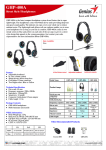

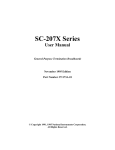
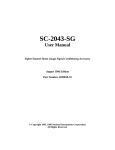
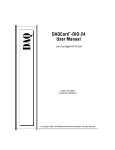
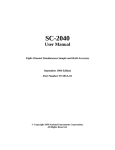
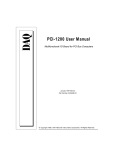

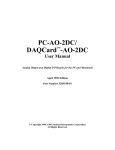
![[Unlocked] SC-2042](http://vs1.manualzilla.com/store/data/005660029_1-1367986a5e7a7fe673239a9957384234-150x150.png)
